PROBset1_2015 - University of Toronto, Particle Physics and
advertisement
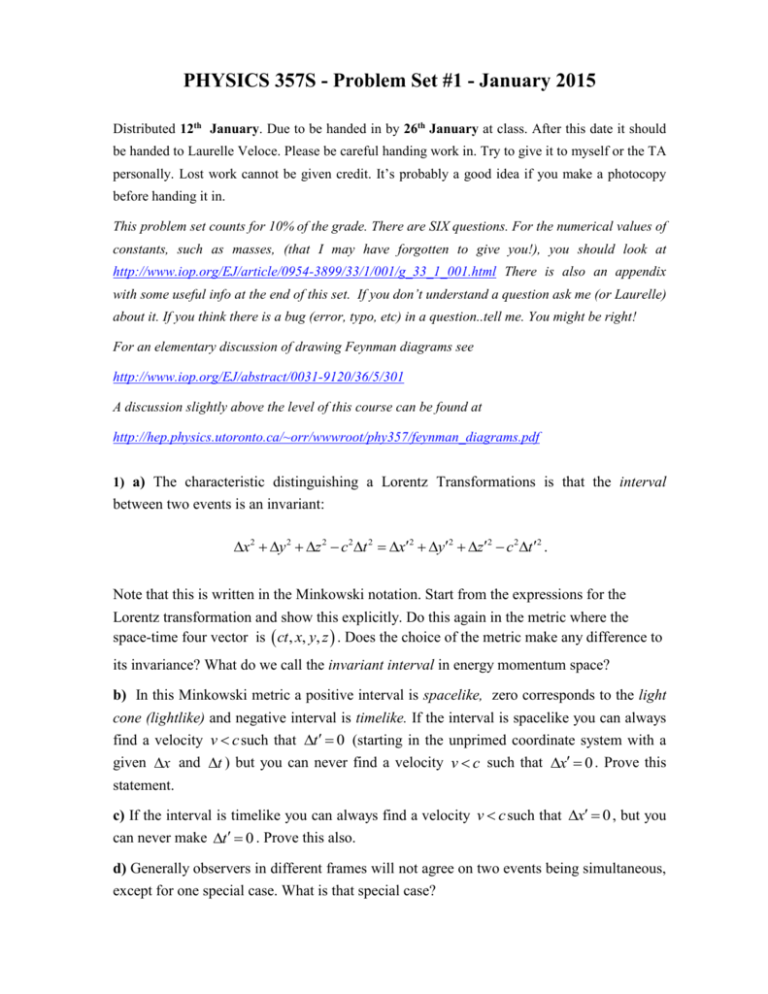
PHYSICS 357S - Problem Set #1 - January 2015 Distributed 12th January. Due to be handed in by 26th January at class. After this date it should be handed to Laurelle Veloce. Please be careful handing work in. Try to give it to myself or the TA personally. Lost work cannot be given credit. It’s probably a good idea if you make a photocopy before handing it in. This problem set counts for 10% of the grade. There are SIX questions. For the numerical values of constants, such as masses, (that I may have forgotten to give you!), you should look at http://www.iop.org/EJ/article/0954-3899/33/1/001/g_33_1_001.html There is also an appendix with some useful info at the end of this set. If you don’t understand a question ask me (or Laurelle) about it. If you think there is a bug (error, typo, etc) in a question..tell me. You might be right! For an elementary discussion of drawing Feynman diagrams see http://www.iop.org/EJ/abstract/0031-9120/36/5/301 A discussion slightly above the level of this course can be found at http://hep.physics.utoronto.ca/~orr/wwwroot/phy357/feynman_diagrams.pdf 1) a) The characteristic distinguishing a Lorentz Transformations is that the interval between two events is an invariant: x 2 y 2 z 2 c 2 t 2 x2 y2 z2 c 2t 2 . Note that this is written in the Minkowski notation. Start from the expressions for the Lorentz transformation and show this explicitly. Do this again in the metric where the space-time four vector is ct , x, y, z . Does the choice of the metric make any difference to its invariance? What do we call the invariant interval in energy momentum space? b) In this Minkowski metric a positive interval is spacelike, zero corresponds to the light cone (lightlike) and negative interval is timelike. If the interval is spacelike you can always find a velocity v c such that t 0 (starting in the unprimed coordinate system with a given x and t ) but you can never find a velocity v c such that x 0 . Prove this statement. c) If the interval is timelike you can always find a velocity v c such that x 0 , but you can never make t 0 . Prove this also. d) Generally observers in different frames will not agree on two events being simultaneous, except for one special case. What is that special case? 2) In class I showed the following transparency Assume the colliding particles have masses m1 , m2 and scatter through an angle . Show that the first diagram has a negative 4-momentum transfer q 2 . First do this assuming nothing about the relative values of the energies and masses involved. Just multiply the scalar product out, and think about the possible extreme values of each term. Then do it where you assume that the process is at very high energy, where E m . Now consider the second diagram in the same high energy domain and show that q 2 has to be positive. Just multiply out the pq2 , as you would for any other 3-vector. Note that q 2 is a 4-vector dotted with itself, so it is Lorentz invariant, so we can work in any arbitrary frame, as q 2 has the same value in all Lorentz frames … that’s what we mean by “invariant”. 2 3) When Pauli proposed the existence of the neutrino, he doubted if it would ever be experimentally observed. He thought this because it was electrically neutral, and massless (we now know that neutrinos have a tiny mass, but you can treat them as identically massless in most cases). We now perform experiments with intense beams of neutrinos. These are formed by directing a high energy proton beam onto a stationary target. Among the particles produced in such relativistic collisions are many kaons. The kaons are allowed to decay in a long evacuated tunnel through the process, K The muons are absorbed in a massive iron shield, and the result is a beam of neutrinos. You can find more details on page 367 of the text book. i) What feature of what kind of decay process led Pauli to propose the existence of the neutrino? You probably learned this in first year. ii) Suppose the kaons have a momentum of 1000 GeV c when they enter the evacuated tunnel. Calculate what proportion of them decay in the tunnel if it is 650 m long. Do the same calculation for pions of momentum 1 MeV c . 4) Any unstable system like a particle or a nucleus can usually decay in various ways. These are decay modes. The fraction decaying by each mode is known as the branching fraction. Consider a system whose partial transition rates to two decay modes are 1 and 2 . These are independent, so the total transition rate for the decaying system is dN 1 N 2 N . dt i) Write down an expression for number of (e.g.) nuclei at t, N t in terms of N 0 , the initial number of nuclei, and the two partial transition rates. iii) Show that the total transition rate is just the sum of the partial transition rates. 1 Further, show that the mean lifetime of the nucleus is given by 1 1 2 iv) What are the fractions f1 and f 2 of nuclei decaying via each branch, in terms of ii) v) the total transition rate and the two partial transition rates? Extend this to n decay modes. Assume that positive K meson ( K ) can decay in six different ways (See table on next page). We’ll learn more about these final state particles. You don’t need to know anything about them here; but, look for “systematics” in the decays. Write down any that you notice. Calculate the six different partial transition rates from the following table. 3 Decay Mode K Branching Fraction K 0.212 0.635 0 K 0.056 K 0 0 K 0 0.017 0.032 K e e Partial Transition Rate s 1 0 0.048 5) (a) If a parent nucleus (1) decays to a daughter nucleus (2), which is also radioactive, then the equations governing the growths and decays are dN1 t 1 N1 t , dt dN 2 t 2 N 2 t 1 N1 t . dt In any situation, the outcome depends on the relative decay rates. However, take mean lifetime of 7.2 days, and is a -emitter, giving decays by -emission to 206 82 Bi which has a Po (mean life 200 days), which in turn Pb (again, look at the number of protons and neutrons). stable. If the source initially only contains maximum? Note: nuclei are labeled as 210 84 210 83 210 83 numer of (protons + neutrons) number of protons 206 82 Pb is Bi , after how long will the rate of -emission be a Chemical Symbol (b) You know that Uranium has two isotopes (i.e. species with the same number of protons, but different numbers of neutrons) 238 92 U and 235 92 U . The isotope 235 92 U easily fissions into lighter nuclei, and about 200MeV of energy is released. This is what powers a reactor. Now 235 U fissions produce a 137Cs within about 5 minutes. The mean lifetime of 5.9% of all 92 137 Cs is 44 years. It is a very dangerous isotope if released into the atmosphere. However at Chernobyl they did indeed contrive to release the contents of the reactor into the atmosphere. Estimate the activity in becquerel (bq) of the 137Cs in a nuclear reactor running at 3 Gigwatts thermal power for one year. In the Chernobyl accident 13% of this isotope was released form the reactor. Estimate the mean activity induced per square meter if the wind blew it over a million square kilometers. Do you think this is dangerous? Compare this to the radiation released at Fukushima (which means “Lucky Island” in Japanese) by reading the website referred to in lecture#1. 4 (6) Here are some questions about Feynman diagrams. When you draw them, use the ones I did as examples. Remember to put in little arrows showing the direction of particles and antiparticles, also label each line. Also remember that electric charge is conserved at each vertex of a Feynman diagram. Make sure that you understand what is a virtual particle line, and what is a freely propagating particle line. Virtual lines do not have arrows on them .... why is that? Here are some questions about Feynman diagrams. When you draw them, use the ones I did as examples. Remember to put in little arrows showing the direction of particles and antiparticles, also label each line. Also remember that electric charge is conserved at each vertex of a Feynman diagram. Make sure that you understand what is a virtual particle line, and what is a freely propagating particle line. Virtual lines do not have arrows on them .... why is that? a) Sketch the lowest order Feynman diagram representing Delbruck Scattering, , which is the scattering of light by light. Could this process happen in classical electrodynamics ( in a vacuum)? Why? b) Elastic scattering between electrons and positrons, e e e e , is known as Bhabha scattering after the Indian physicist of that name. In the LEP electron positron colider at CERN, each beam had an energy of 100 GeV. Determine the mass of the virtual photon in Bhabha scattering at LEP. What is the velocity of the virtual photon? Is that possible for real photons? c) Compton scattering is the scattering of photons off of electrons. Draw all the 4th order diagrams (ones with four vertices) for this process. There are 17 of them! These represent very small corrections to the leading order process. Try to think of all electron and photon loops; but, don’t worry of you can only find 15 or 16, the last one is a very small correction to your final grade ( a small perturbation…eh? )Remember that all the lines have to be connected; except the ends of the incoming and outgoing particles. d) In the introductory lecture I mentioned that the Z 0 was a mediator of the weak interaction. So, it couples weakly to both , and to the charged mediators of the weak interaction, W ,W . I also said that the weak and electromagnetic interactions were really the same interaction. That means that a process taking place via virtual photon exchange, can equally well take place through virtual Z 0 exchange. Now, draw all the lowest order diagrams contributing to the process W W ; assuming that the weak and electromagnetic interactions have equal strength. Muon colliders have been proposed as an alternative to electron positron colliders. Why would a muon collider only work at at high enery, while you can make an electron positron collider at any (even very low) energy you choose? 5 e) Draw leading order Feynman diagrams (in terms of quark transitions if hadrons are involved) for the following weak decays (??? How do I know that they are weak decays??). Notice how I leave the “+” out between the different final state particles. pe e K 0 0e e Use the Feynman diagrams I showed for weak interaction processes as a guide. Note that quark content of the is (sud), that of the K 0 is (d, anti-s) 6 Possibly Useful Physical Constants: 6 1023 mole1 Avogadro No: pi speed of light: 3.1416 c 3.0 108 m s 6.6 1022 MeV s c 197 MeV . fm Plank's constant: c 2 0.4 GeV 2 mb 1 eV 1.6 1019 Joules 1 eV c 2 1.8 1036 kg 1 fm 1015 m 1 mb 1027 cm2 1 year 1 year 107 s electron charge: electron magnetic moment: e 1.602 1019 C e 9.31024 Joules Tesla1 fine structure constant: e2 strong coupling constant: c 1 137.0360 s M Z 0.116 0.005 Fermi coupling constant: Cabibbo angle: GF 1.166 105 GeV 2 sin C 0.22 Weak mixing angle: sin 2 W M Z 0.2319 0.0005 BR Z e e 3.21 0.07% Branching Ratios BR Z hadrons 71 1% ________________________________________________________________________ 7 Particle Properties Boson gluon W Mass GeV c 2 Lepton e 3 1036 ~0 80.22 e Z0 91.187 H0 125 Hadron , 0 , Mass MeV c 2 Quark Content ud , uu dd 2 , du 139.57,134.97, 139.57 Mass MeV c 2 105 0.510999 0.27 105.658 10 1777 1 0 I J PC K, K us , su 493.65 1 0 2 K 0, K 0 ds , sd 497.67 1 0 2 , 0, ud , uu dd 2 , ud 775.7 11 p ,n uud , udd 938.27, 939.57 11 2 2 , 0 , , ddd , udd , uud , uuu 1232 33 2 2 0 uds 1115.6 1 0 2 D0 , D0 uc , cu 1863 1 0 2 D , D dc , cd 1869 1 0 2 DS , DS cs , cs 1968 B , B ub , ub 5279 c udc 2285 , 0 , uus, uds, dds 1189 1 0 , uss, dss 1315 11 2 2 sss 1672 b udb 5624 8 0 0 1 0 2 1 0 2 1 2 3 0 2 1 0 2 9
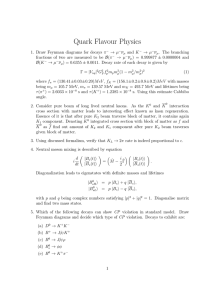

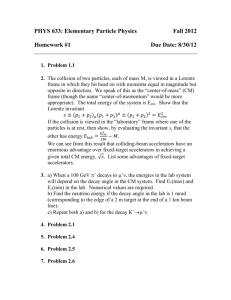
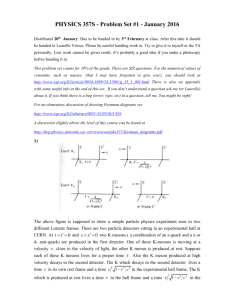



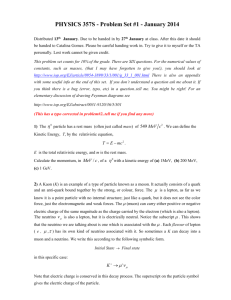


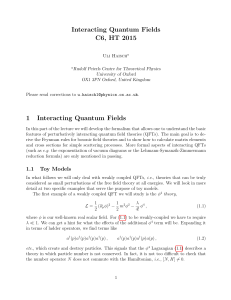
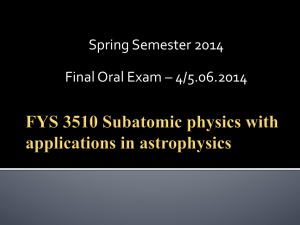
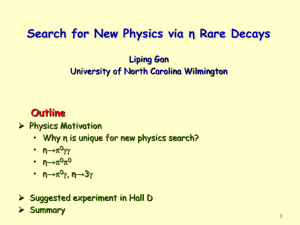
![Search for the decay modes B[superscript ±]h[superscript ±] Please share](http://s2.studylib.net/store/data/012638194_1-a7b1e4d3c1dfb8f216605e419266ad65-300x300.png)